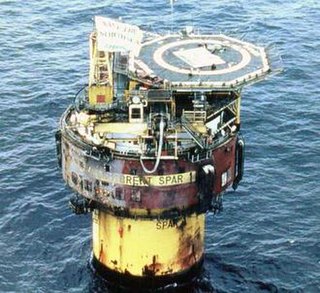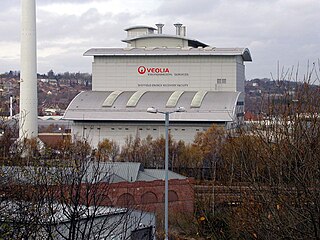Related Research Articles

The Basel Convention on the Control of Transboundary Movements of Hazardous Wastes and Their Disposal, usually known as the Basel Convention, is an international treaty that was designed to reduce the movements of hazardous waste between nations, and specifically to prevent transfer of hazardous waste from developed to less developed countries. It does not, however, address the movement of radioactive waste. The convention is also intended to minimize the rate and toxicity of wastes generated, to ensure their environmentally sound management as closely as possible to the source of generation, and to assist developing countries in environmentally sound management of the hazardous and other wastes they generate.

Incineration is a waste treatment process that involves the combustion of substances contained in waste materials. Industrial plants for waste incineration are commonly referred to as waste-to-energy facilities. Incineration and other high-temperature waste treatment systems are described as "thermal treatment". Incineration of waste materials converts the waste into ash, flue gas and heat. The ash is mostly formed by the inorganic constituents of the waste and may take the form of solid lumps or particulates carried by the flue gas. The flue gases must be cleaned of gaseous and particulate pollutants before they are dispersed into the atmosphere. In some cases, the heat that is generated by incineration can be used to generate electric power.

The Fresh Kills Landfill was a landfill covering 2,200 acres (890 ha) in the New York City borough of Staten Island in the United States. The name comes from the landfill's location along the banks of the Fresh Kills estuary in western Staten Island.
The Mobro 4000 was a barge owned by MOBRO Marine, Inc. made infamous in 1987 for hauling the same load of trash along the east coast of North America from New York City to Belize and back until a way was found to dispose of the garbage. During this journey, local press often referred to the Mobro 4000 as the "Gar-barge".

Brent Spar, or Brent E, was a North Sea oil storage and tanker loading buoy in the Brent oilfield, operated by Shell UK. With the completion of a pipeline connection to the oil terminal at Sullom Voe in Shetland, the storage facility had continued in use, but by 1991, was considered to be of no further value. Brent Spar became an issue of public concern in 1995, when the British government announced its support for Shell's application for its disposal in deep Atlantic waters at North Feni Ridge.

Marine debris, also known as marine litter, is human-created solid material that has deliberately or accidentally been released in a sea or ocean. Floating oceanic debris tends to accumulate at the center of gyres and on coastlines, frequently washing aground, when it is known as beach litter or tidewrack. Deliberate disposal of wastes at sea is called ocean dumping. Naturally occurring debris, such as driftwood and drift seeds, are also present. With the increasing use of plastic, human influence has become an issue as many types of (petrochemical) plastics do not biodegrade quickly, as would natural or organic materials. The largest single type of plastic pollution (~10%) and majority of large plastic in the oceans is discarded and lost nets from the fishing industry. Waterborne plastic poses a serious threat to fish, seabirds, marine reptiles, and marine mammals, as well as to boats and coasts.

Cory is a recycling and waste management company based in London. Originally founded as William Cory & Son in 1896, the company has operated vessels on the River Thames for more than 125 years, transporting a range of commodities and materials including coal, oil, aggregates and waste. Ships from Cory's fleet supported Britain's war efforts in both world wars, with 30 ships being lost during the conflicts. From the 1980s onwards, the business has become increasingly focused on waste management.

The 2006 Ivory Coast toxic waste dump was a health crisis in Ivory Coast in which a ship registered in Panama, the Probo Koala, chartered by the Singaporean-based oil and commodity shipping company Trafigura Beheer BV, offloaded toxic waste to an Ivorian waste handling company which disposed of it at the port of Abidjan. The local contractor, a company called Tommy, dumped the waste at 12 sites in and around the city in August 2006. The dumping, which took place against a backdrop of instability in Abidjan as a result of the country's first civil war, allegedly led to the death of 7 and 20 hospitalisations, with a further 26,000 people treated for symptoms of poisoning.

The Sheffield Energy Recovery Facility, also known as the Energy from Waste Plant, is a modern incinerator which treats Sheffield's household waste. It is notable as it not only provides electricity from the combustion of waste but also supplies heat to a local district heating scheme, making it one of the most advanced, energy efficient incineration plants in the UK. In 2004, the district heating network prevented 15,108 tonnes of CO2 from being released from buildings across the city, compared to energy derived from fossil fuels. The incinerator is a 'static asset' owned by Sheffield City Council and operated by Veolia Environmental Services under a 35 year integrated waste management contract (IWMC)/PFI contract.

USS LST-519 was an LST-491-class tank landing ship built for the U.S. Navy in World War II. She was later renamed USS Calhoun County (LST-519) after counties in eleven states in the United States.
Bovril boats, also known formally as sludge vessels, were specially designed sewage dumping vessels that operated on the River Thames from 1887 to 1998. Their task was to remove London's human solid waste from Beckton and Crossness for disposal on the ebb tide at sea, at Black Deep, an extremely deep part of the North Sea fifteen miles off Foulness, on one of the main approaches to the Thames Estuary. Similar boats operated on the Manchester Ship Canal, the Tyne, and elsewhere.

Operation CHASE was a United States Department of Defense program for the disposal of unwanted munitions at sea from May 1964 until the early 1970s. Munitions were loaded onto ships to be scuttled once they were at least 250 miles offshore. While most of the sinkings involved conventional weapons, four of them involved chemical weapons. The disposal site for the chemical weapons was a three-mile (5 km) area of the Atlantic Ocean between the coast of the U.S. state of Florida and the Bahamas. Other weapons were disposed of in various locations in the Atlantic and Pacific oceans. The CHASE program was preceded by the United States Army disposal of 8,000 short tons of mustard and lewisite chemical warfare gas aboard the scuttled SS William C. Ralston in April 1958. These ships were sunk by having Explosive Ordnance Disposal (EOD) teams open seacocks on the ship after they arrived at the disposal site. The typical Liberty ship sank about three hours after the seacocks were opened.

Johnston Atoll Chemical Agent Disposal System (JACADS) was the U.S. Army's first chemical munitions disposal facility. It was located on Johnston Island, at Johnston Atoll and completed its mission and ceased operation in 2000.
Waste management in Japan today emphasizes not just the efficient and sanitary collection of waste, but also reduction in waste produced and recycling of waste when possible. This has been influenced by its history, particularly periods of significant economic expansion, as well as its geography as a mountainous country with limited space for landfills. Important forms of waste disposal include incineration, recycling and, to a smaller extent, landfills and land reclamation. Although Japan has made progress since the 1990s in reducing waste produced and encouraging recycling, there is still further progress to be made in reducing reliance on incinerators and the garbage sent to landfills. Challenges also exist in the processing of electronic waste and debris left after natural disasters.
The 'Ndrangheta, a criminal organization from Calabria, Italy, has been involved in radioactive waste dumping since the 1980s. Ships with toxic and radioactive waste were sunk off the Italian coast. In addition, vessels were allegedly sent to Somalia and other developing countries with toxic waste, including radioactive waste cargoes, which were either sunk with the ship or buried on land. The introduction of more rigorous environmental legislation in the 1980s made illegal waste dumping a lucrative business for organized crime groups in Italy. The phenomenon of widespread environmental crime perpetrated by criminal syndicates like the Camorra and 'Ndrangheta has given rise to the term "ecomafia".

MT Vulcanus, also known as Vulcanus I, Oragreen, Kotrando, and Erich Schröder, is a cargo ship first placed in service in 1956 that was used from 1972 to 1990 as an incinerator ship and later as a tanker.
The global waste trade is the international trade of waste between countries for further treatment, disposal, or recycling. Toxic or hazardous wastes are often imported by developing countries from developed countries.
Greenaction for Health and Environmental Justice, formed in 1997, is a multiracial grassroots organization based in San Francisco that works with low-income and working class urban, rural, and indigenous communities. It runs campaigns in the United States to build grassroots networks, and advocate for social justice.

New York City's waste management system is a refuse removal system primarily run by the New York City Department of Sanitation (DSNY). The department maintains the waste collection infrastructure and hires public and private contractors who remove the city's waste. For the city's population of more than eight million, The DSNY collects approximately eleven thousand tons a day of garbage, including compostable material and recycling.

The MV Wakashio oil spill occurred after the Japanese-controlled bulk carrier Wakashio ran aground on a coral reef on 25 July 2020 at around 16:00 UTC. The ship began to leak fuel oil in the following weeks, and broke apart in mid August. Although much of the oil on board Wakashio was pumped out before she broke in half, an estimated 1,000 tonnes of oil spilled into the ocean in what was called by some scientists the worst environmental disaster ever in Mauritius. Two weeks after the incident, the Mauritian government declared the incident a national emergency.
References
- 1 2 3 4 5 6 7 8 Cunningham, William P & Mary A (2004). Principles of Environmental Science. McGrw-Hill Further Education. p. Chapter 13, Further Case Studies. ISBN 0072919833.
- ↑ Knight, Danielle (3 Nov 1998). "U.S. Toxic Waste to be Returned to Sender". Inter-Press Agency. Retrieved 6 April 2013.
- 1 2 3 4 5 6 7 Leonard, Annie (2010). The Story of Stuff . New York: Simon & Schuster. pp. 224–226. ISBN 9781-4391-2566-3.
- 1 2 3 4 5 Reeves, Hope (2001-02-18). "A Trail of Refuse". New York Times - Magazine. Retrieved 5 April 2013.
- 1 2 Detjen, Jim (4 June 1993). "2 Khian Sea Officials Convicted Of Perjury". The Philadelphia Inquirer. Retrieved 5 April 2013.
- ↑ "Khian Sea: The Wandering Garbage Barge". www.amusingplanet.com. Retrieved 2024-04-23.
- 1 2 Smith, Ramona (8 Oct 2008). "We're Told to Haul Ash". Daily News, Philadelphia. Retrieved 6 April 2013.
- 1 2 Avril, Tom (15 Jun 2002). "Traveling trash. Years later, long-fought ash returning". The Philadelphia Inquirer. Retrieved 6 April 2013.